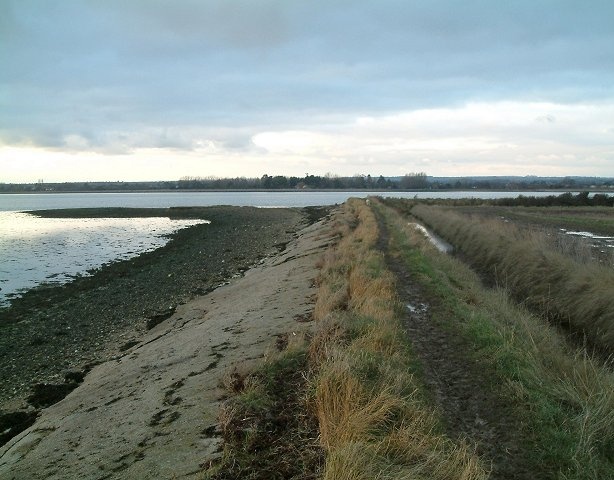
13 November 2013
Breach an earthwork like the one above, give back land to the sea, and you’ll get fewer floods.
After Hurricanes Katrina and Sandy, U.S. emergency managers and town planners are discussing giving back land to the ocean as a way to protect still-viable coastal communities. It’s a concept called “managed retreat,” a name that conjures loss and sometimes sparks defiance in those who live at the ocean’s door.
In the U.K. they’ve recently returned more than 450 acres to the sea by breaching an earthwork just five miles from this one at Chidham Point. The locals are excited about it. They expect the resulting salt marsh to increase tourism. Here’s how:
At Medmerry on the south coast of England, shingle(*) sea walls were supposed to protect towns and undeveloped land but in recent years have proved inadequate. Stronger storms and higher tides frequently flooded the low-lying communities, especially the caravan (campers) vacation parks. Some sections of Selsey and Bracklesham Bay are below sea level. It wasn’t working.
In 2011 the U.K.’s Environment Agency began a managed retreat project in West Sussex. They built four miles of new sea walls up to a mile inland around the developed areas. They also built drainage ditches and ponds, two parking lots for visitors, and 10km of bicycle paths and horse trails. Then they breached the earthworks and gave land back to the sea. The resulting salt marsh buffers the ocean’s rage.
It’s also great for wildlife. Even while construction was underway migrating water birds stopped by to visit the growing new salt marsh. Bird watching improved immediately and is expected to get even better in the months and years ahead. The new salt marsh will be a birding tourist destination.
Give back to the sea and get back safety and tourism. Compromise with Mother Nature is good.
Read more about this project and see a video here at the BBC News.
(photo of dike at Chidham Point, West Sussex, UK, located about 5 miles from Medmerry)
(*) The British word “shingle” means the sand, pebbles, cobbles and shell-pieces that make up the beach.
I’ve always felt it’s wrong for people to try to force an environment to become an area that will support their lifestyle. I think this is true for those out West that are sucking the rivers dry to water their lawns and fill their swimming pools, and for people who live in flood plains or areas where they’ve built below sea level and need walls to hold back the water. People should live in an environmentally sustainable way.
As an aside to this, in our last house, we had some woods behind and beside the house, and I always had bird feeders and birdbaths available, planted flowering native plants and bushes, and used little if any chemicals on our lawn. We had lots of butterflies and birds around our house. The people who bought the house cut down all the bushes, tore out all of my flowers, and planted some non-native dwarf evergreens in a few spots and covered the rest of the flower beds with black plastic covered in rocks. Traditional suburban lifestyle is not ecofriendly.
And, a patch of wooded hillside bordering a local farm has been bulldozed to create a terraced housing development devoid of plant or animal life. I think the denuding of the slope caused excessive runoff into the farmers pond because I’ve noticed it now has aeration units in it. I don’t understand why developers can’t leave some of the existing plant life in place when they develop a piece of property. What used to be a nice environment for native plants and animals is now an ugly barren hillside with big houses on it.
Good to see some people are “figuring out” that, (short of an epocolyptic event) that nature figured out, way before “land management” came into the picture, how to manage the land… It isn’t rocket science to look at what is working, but it baffles me why many people have to do the wrong thing to turn around and “fix” it… I’ll never understand it!!
It’s Good though… that the area described is going to be able to become a natural place again…A whole lot of money was wasted, over time, on that one area… Now maybe it will be a model for making money, and saving it…